Welcome to our Great Dane training guide, where you’ll discover the secrets to mastering training for your gentle giant.
Factual data: Mastering your Great Dane’s training requires a combination of socialization, obedience, and advanced training. Starting early with socializing your puppy is crucial, introducing them to new environments, people, and other animals. Obedience training should focus on basic commands like sit, stay, come, down, heel, and no, and should be practiced in various settings to build focus and composure. Advanced training can involve skills like retrieving items or responding to hand signals. To become a certified therapy dog, accreditations such as obedience training certificates, Canine Good Citizen accreditation, and therapy dog certification can be pursued. Once your Great Dane has achieved these certifications, you can start booking therapy gigs at places like hospitals, libraries, nursing homes, and assisted living facilities.
Key Takeaways:
- Start socializing your Great Dane from a young age to help them become well-rounded companions.
- Consistently practice obedience training with basic commands in different environments.
- Explore advanced training techniques to further enhance your Great Dane’s skills.
- Consider crate training as a beneficial method for house training your Great Dane.
- Utilize positive reinforcement training methods, such as treats and praise, to encourage desired behaviors.
The Importance of Socialization for Great Danes
Socialization is a crucial aspect of Great Dane training, as it helps them become comfortable in various situations and interact positively with people and animals. It is important to start socializing your Great Dane from a young age to ensure they develop into well-rounded companions.
Introducing your Great Dane puppy to different environments, people, and animals early on can help prevent behavioral issues later in life. Exposing them to new experiences gradually and positively reinforces their ability to adapt and handle unfamiliar situations.
During socialization, encourage your Great Dane to interact with friendly and vaccinated dogs, as this can improve their social skills and enable them to understand and respond appropriately to canine communication. Exposing them to different types of people, including children, adults, and strangers, helps them become more comfortable and confident in various social settings.
To aid the socialization process, consider enrolling your Great Dane in puppy socialization classes or arranging playdates with other well-behaved dogs. These opportunities can provide them with positive experiences and help them build trust and confidence.
Benefits of Socialization for Great Danes:
- Reduces fear and anxiety in new environments
- Promotes appropriate behavior around people and other animals
- Enhances their ability to handle new experiences and situations calmly
- Prevents aggression or fear-based reactions towards strangers or other dogs
- Creates a well-adjusted and confident companion
Remember, socialization should be a positive and gradual process. Take your time, be patient, and always ensure the experiences are enjoyable for your Great Dane. By prioritizing socialization, you are setting the foundation for a well-behaved, happy, and socially adept companion.
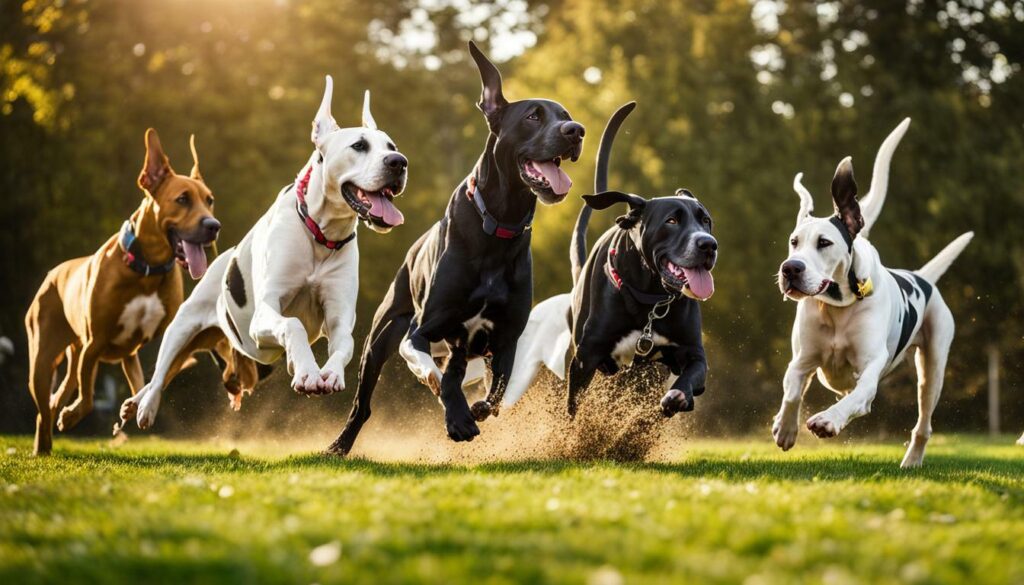
Obedience training is essential for Great Danes to ensure they respond appropriately to commands and exhibit good manners in various situations. Starting with basic commands like sit, stay, come, down, heel, and no, you can establish a foundation of discipline and control. Consistent practice is key, and training should take place in different environments to enhance their focus and adaptability.
Once your Great Dane has mastered the basics, you can move on to advanced training techniques. This can involve teaching them tasks like retrieving items or responding to hand signals, providing mental stimulation and further enhancing their training. Advanced training not only strengthens their skills but also deepens the bond between you and your furry companion.
Training Tips for Obedience Training
- Start training your Great Dane from a young age to establish good habits early on.
- Use positive reinforcement techniques, such as treats, praise, and play, to reward desired behaviors.
- Keep training sessions short and frequent to maintain your dog’s attention and prevent boredom.
- Be patient and consistent in your training approach, as Great Danes can be sensitive and respond better to gentle guidance.
- Seek professional guidance or enroll in obedience classes if needed, to ensure proper training techniques and address specific challenges.
Obedience training is not just about teaching your Great Dane to follow commands; it’s about fostering a strong bond, building trust, and creating a well-behaved companion. With patience, consistency, and positive reinforcement, you can help your Great Dane reach their full potential and become a well-mannered member of your family.
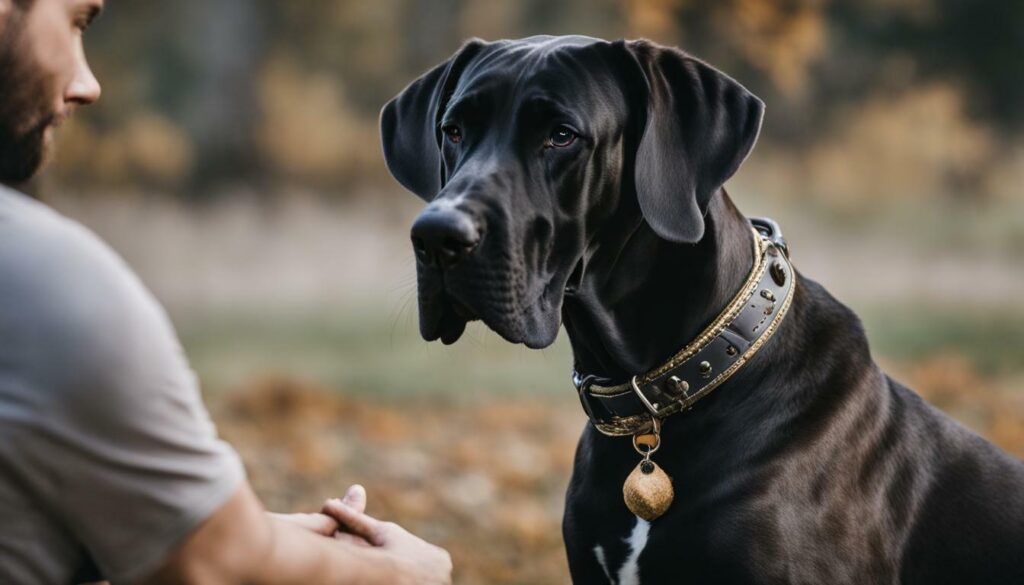
| Benefits of Obedience Training for Great Danes |
|---|
| Improved communication between you and your Great Dane. |
| Enhanced focus and composure in various environments. |
| Increased safety and control in public settings. |
| Reduced behavioral issues, such as jumping or excessive barking. |
| Opportunities for advanced training and certifications. |
Advanced Training Techniques for Great Danes
Once your Great Dane has mastered the basic commands, you can move on to advanced training techniques that challenge their abilities and increase their mental stimulation. These techniques go beyond simple obedience and can help take your Great Dane’s training to the next level.
Retrieving Items
Teaching your Great Dane to retrieve items is not only impressive but also mentally stimulating for them. Start by using their favorite toy or ball and throw it a short distance. Encourage them to bring it back to you and reward them with praise and a treat when they do. Gradually increase the distance and complexity of the task, eventually teaching them to retrieve specific objects by name.
Hand Signals
Training your Great Dane to respond to hand signals is a useful skill, especially in situations where verbal commands may not be practical. Begin by associating specific hand signals with commands they already know, such as a flat hand for “sit” or a raised hand for “stay.” Use consistent gestures and reward them with treats and praise when they respond correctly. With practice, they will learn to understand and obey commands given through hand signals alone.
The “Leave It” Command
The “leave it” command is essential for teaching your Great Dane impulse control and preventing them from picking up or engaging with unwanted objects. Start by holding a treat in your closed hand and tell them to “leave it.” Wait for them to stop trying to get the treat, then reward them with a different treat from your other hand. Practice this command with various objects and gradually increase the difficulty level.
| Advanced Training Techniques for Great Danes |
|---|
| Retrieving Items |
| Hand Signals |
| The “Leave It” Command |
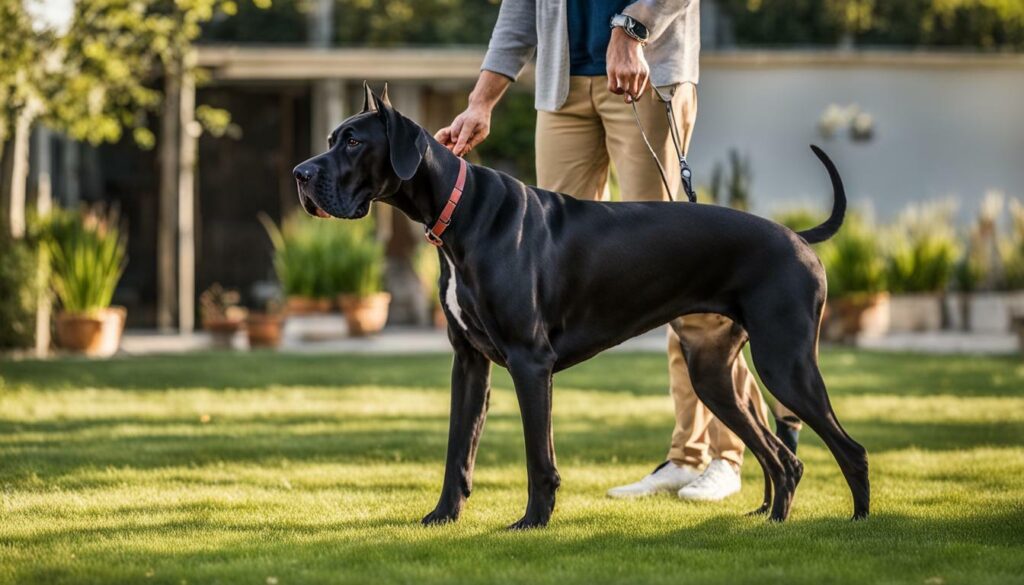
> Note: The image above illustrates the beauty and grace of a trained Great Dane.
House training a Great Dane can be a daunting task, but with the right approach and consistency, you can establish a successful potty training routine. This section will provide you with helpful tips and techniques to make the process smoother for both you and your furry friend.
Establish a Routine: Consistency is key when it comes to house training. Set a regular schedule for feeding and bathroom breaks, and stick to it. Take your Great Dane outside first thing in the morning, after meals, before bedtime, and at regular intervals throughout the day. Remember to praise and reward them when they eliminate in the appropriate spot.
Recognize Signs: Learn to recognize the signs that your Great Dane needs to go outside. These may include sniffing around, circling, whining, or scratching at the door. If you notice any of these behaviors, take them outside immediately. Promptly responding to their cues will help prevent accidents indoors.
Reinforce Positive Behavior: Positive reinforcement is essential in house training. When your Great Dane eliminates outside, offer enthusiastic praise and rewards, such as treats or playtime. This will reinforce the idea that going potty outside is a positive experience. Avoid punishment or scolding for accidents, as this can create fear and anxiety around the toilet training process.
| Do’s | Don’ts |
|---|---|
|
|
Remember, house training takes time and patience. It is important to remain consistent and positive throughout the process. With proper guidance and reinforcement, your Great Dane will soon learn to do their business where they are supposed to, bringing harmony to your home.
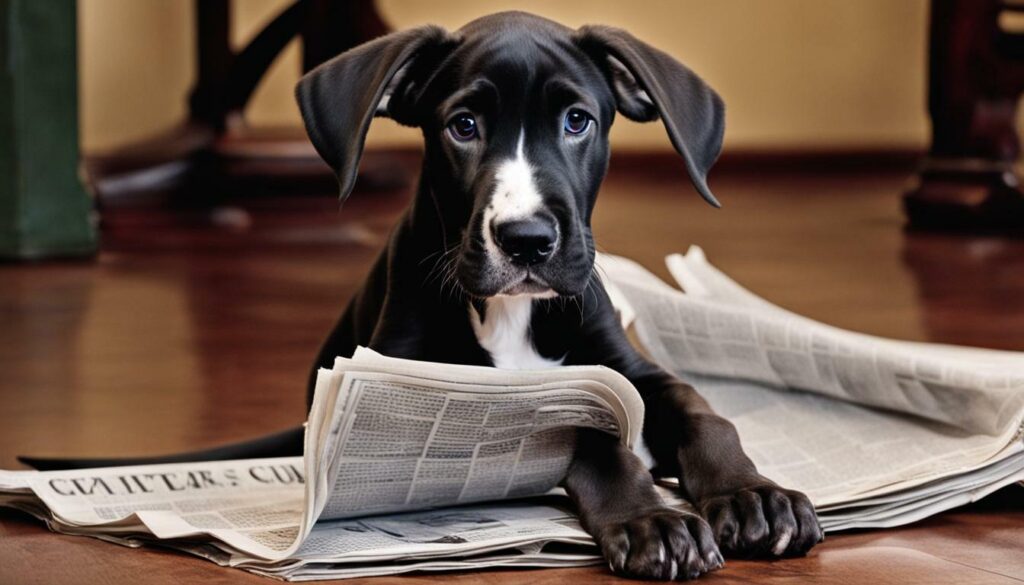
Positive reinforcement training is a highly effective approach for teaching Great Danes, as it encourages and rewards desired behaviors, creating a strong bond between you and your gentle giant. This method focuses on using positive stimuli, such as treats, praise, and play, to motivate your Great Dane to repeat behaviors that you want to reinforce. By associating positive experiences with specific actions, your Great Dane will be more motivated to learn and respond to your commands.
When implementing positive reinforcement training, it’s important to be consistent and patient. Start by identifying the behaviors you want to teach and choose a specific command for each one. For example, use the word “sit” when you want your Great Dane to sit down. When your dog performs the desired behavior, immediately reward them with a treat and praise. This positive association will help your Great Dane understand what is expected of them.
In addition to treats and praise, you can also utilize other rewards during training sessions. Toys, playtime, and affection can be used as additional incentives for your Great Dane. By incorporating a variety of rewards, you can keep the training sessions engaging and enjoyable for both you and your dog.
Tips for Successful Positive Reinforcement Training:
- Be consistent in using the same command words and gestures for each behavior you want to teach.
- Use high-value treats that your Great Dane finds particularly enticing, as these will be more effective in motivating them.
- Keep training sessions short and frequent, as Great Danes have shorter attention spans.
- Avoid punishment or negative reinforcement, as this can harm the trust and bond between you and your dog.
- Stay patient and positive throughout the training process, as it may take time for your Great Dane to fully grasp and master new behaviors.
By utilizing positive reinforcement training techniques, you can foster a loving and respectful relationship with your Great Dane while building a solid foundation of obedience and good behavior. Remember to tailor the training to your dog’s unique personality and preferences, and enjoy the journey of helping your Great Dane reach their full potential.
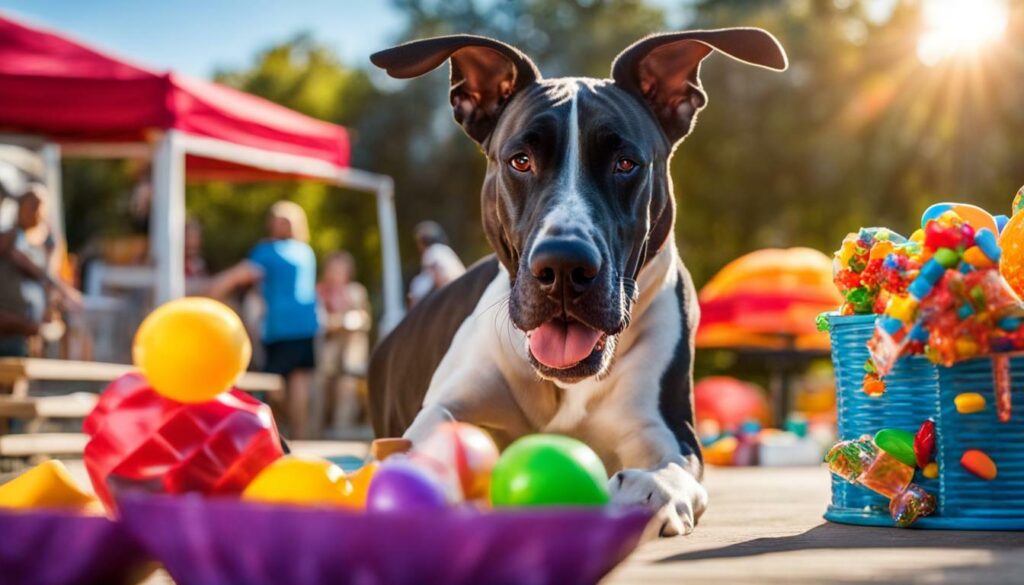
Leash training is an important aspect of Great Dane training, as it instills good walking manners and ensures a pleasant and safe experience for both you and your dog. Great Danes are large and powerful dogs, so establishing control on the leash is essential. Here are some effective techniques to help you leash train your Great Dane:
- Start early: Begin leash training your Great Dane as a puppy to establish good habits from the start. This will make the process easier and more successful.
- Positive reinforcement: Use rewards such as treats, praise, and play to encourage your Great Dane to walk calmly on the leash. Reward them when they walk without pulling or exhibit good leash manners.
- Consistency and patience: Be consistent with your training methods and patient with your Great Dane. Leash training takes time and practice, so remain calm and persistent throughout the process.
- Gentle corrections: When your Great Dane pulls on the leash, avoid yanking or jerking the leash. Instead, use gentle corrections by stopping and changing direction to redirect their attention and discourage pulling.
- Proper equipment: Invest in a sturdy leash and harness that fits your Great Dane comfortably. A harness can provide better control and prevent strain on their neck.
Leash Training Tips
Here are some additional tips to enhance your leash training sessions:
- Start in a quiet and distraction-free environment to help your Great Dane focus on the training.
- Gradually introduce them to busier and more stimulating environments to build their confidence and ability to handle distractions.
- Practice walking on various surfaces, such as grass, pavement, and gravel, to expose your Great Dane to different textures and sensations.
- Keep training sessions short and frequent, gradually increasing the duration as your Great Dane becomes more comfortable and attentive.
- Stay consistent with your expectations and commands, using the same cues each time you want your Great Dane to walk nicely on the leash.
Remember, leash training is a process that requires patience, consistency, and positive reinforcement. With time and dedication, you can enjoy enjoyable and controlled walks with your well-trained Great Dane.
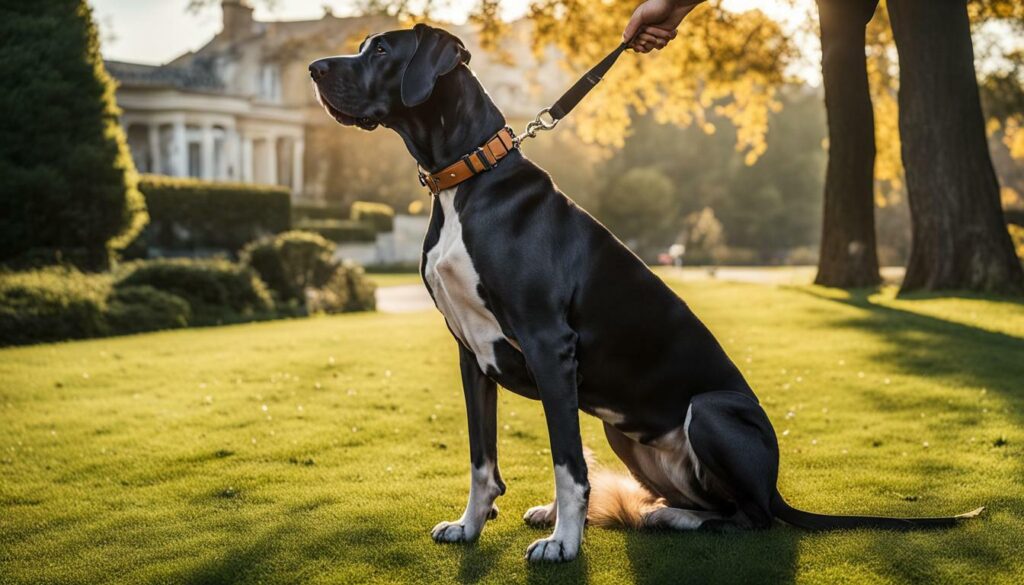
Crate training can be a valuable tool in Great Dane training, providing them with a secure and comfortable space while aiding in house training and preventing destructive behavior. Great Danes are known for their large size, and having a properly sized crate that allows them to stand up, turn around, and lie down comfortably is essential.
When introducing your Great Dane to the crate, make it a positive experience by associating it with rewards and praise. Place their favorite toys or treats inside to entice them to enter. Gradually increase the amount of time they spend inside, starting with short intervals and gradually extending it as they become more comfortable.
| Benefits of Crate Training | Tips for Successful Crate Training |
|---|---|
| 1. Provides a safe and secure space for your Great Dane, especially when you’re away from home. | 1. Choose an appropriate crate size to ensure your Great Dane has enough room to move comfortably. |
| 2. Helps with house training by teaching your Great Dane to hold their bladder and bowels. | 2. Never use the crate as a form of punishment. It should be seen as a positive and comforting place for your Great Dane. |
| 3. Prevents destructive behavior, such as chewing on furniture or getting into hazardous items. | 3. Gradually increase the time your Great Dane spends in the crate to avoid anxiety or distress. |
| 4. Facilitates travel and provides a familiar space for your Great Dane in new environments. | 4. Make the crate inviting and comfortable by adding soft bedding or blankets. |
Remember, crate training should never be used as a means of confinement for long periods. Great Danes are social animals and need regular exercise, mental stimulation, and human interaction. A properly crate-trained Great Dane will view their crate as their den, a place they can retreat to when they need rest or alone time.
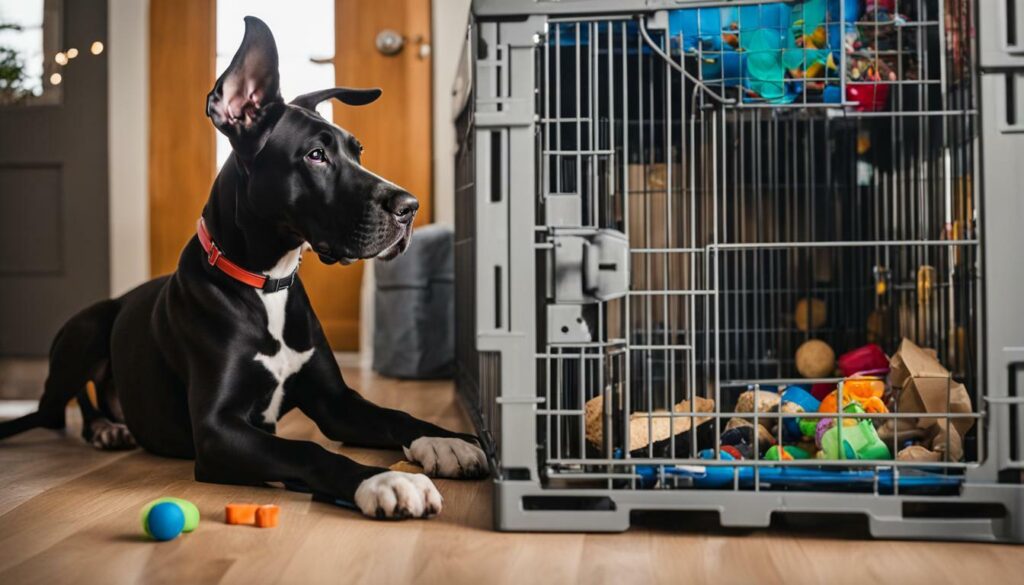
When selecting a crate for your Great Dane, consider their adult size and choose a crate that provides adequate space for them to move comfortably. Look for crates made of sturdy materials that can withstand their strength and ensure proper ventilation. Avoid using crates with excessive space as it may encourage your Great Dane to use one area for sleeping and another for eliminating.
In conclusion, crate training is a valuable tool in Great Dane training that provides benefits for both you and your furry companion. By following the proper steps and creating a positive association with the crate, you can help your Great Dane develop good behavior habits, feel secure, and have a safe space they can call their own.
Great Dane Behavior Training
Effective behavior training is crucial for addressing and managing any problematic behaviors that may arise in Great Danes, ensuring a harmonious relationship between you and your gentle giant. With their imposing size and strength, it’s essential to establish clear boundaries and shape their behavior from an early age. Whether it’s jumping, chewing, barking, or separation anxiety, proper training techniques can help correct these issues and turn your Great Dane into a well-mannered and balanced companion.
One effective approach to behavior training is positive reinforcement. Rewarding desired behaviors, such as sitting calmly or walking politely on a leash, encourages your Great Dane to repeat those actions. Treats, praise, and play can serve as powerful motivators during training sessions. By focusing on positive reinforcement, you create a positive association with training, making it an enjoyable and rewarding experience for both you and your dog.
Consistency is key when it comes to behavior training. Establishing a regular training schedule and using consistent commands and cues help your Great Dane understand what is expected of them. Set clear boundaries and enforce them consistently, ensuring that everyone in the household follows the same rules. This consistency establishes a sense of structure and helps your Great Dane feel secure and confident in their environment.
| Common Behavioral Issues in Great Danes | Training Strategies |
|---|---|
| Jumping | Ignore the jumping behavior and reward calm greetings. Teach your Great Dane an alternative behavior, such as sitting or offering a paw. |
| Chewing | Provide appropriate chew toys and redirect their attention when they start chewing on inappropriate items. Reward them when they chew on the designated toys. |
| Barking | Identify the triggers for barking and address the underlying cause. Use commands like “quiet” or a distraction technique to redirect their attention. Reward them for being calm and quiet. |
| Separation Anxiety | Gradually desensitize your Great Dane to your departures by practicing short absences and gradually increasing the duration. Provide them with toys or puzzles to keep them occupied when you’re away. |
While behavior training can be challenging at times, patience and persistence are key. Seek professional guidance or enroll in obedience classes if needed. Remember, every Great Dane is unique, and training strategies may need to be tailored to their individual needs and personality. With consistent training, positive reinforcement, and a loving approach, you can help your Great Dane become a well-behaved and happy member of your family.

If you aspire to turn your Great Dane into a therapy dog, this section will guide you through the certifications and training required to embark on this fulfilling journey. Becoming a certified therapy dog opens up a world of opportunities to bring joy and comfort to those in need, whether it’s in hospitals, libraries, nursing homes, or assisted living facilities.
To begin the process, it is essential to focus on obedience training and socialization for your Great Dane. They should have a solid foundation in basic commands, such as sit, stay, come, and leave it. Obedience training certificates and the Canine Good Citizen accreditation are often prerequisites for therapy dog certification.
In addition to obedience training, therapy dog certification typically involves completing a series of evaluations and tests to ensure your Great Dane has the temperament and behavior necessary for therapy work. These evaluations may assess their ability to remain calm in various situations, interact gently with strangers, and follow commands reliably.
Once your Great Dane has obtained the necessary certifications, it’s time to start booking therapy gigs. Reach out to local hospitals, libraries, nursing homes, and assisted living facilities to inquire about their therapy dog programs. Many places have specific requirements and guidelines for therapy visits, so be sure to familiarize yourself with their protocols and procedures.
Embarking on the journey to train your Great Dane as a therapy dog can be a rewarding experience not only for you but also for the people your furry companion will touch with their loving and gentle nature. Start with obedience training and socialization, work towards securing the required certifications, and before you know it, your Great Dane will be making a positive impact in the lives of those in need.
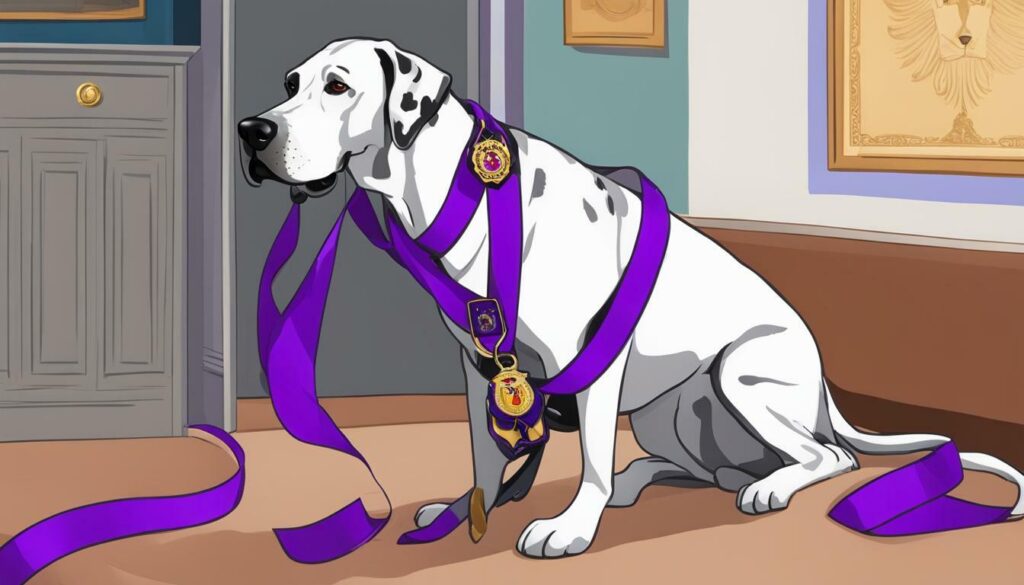
Once your Great Dane has achieved the necessary certifications, you can start booking therapy gigs, bringing comfort and joy to those in need across various settings. As a certified therapy dog, your Great Dane can make a positive impact on individuals in hospitals, libraries, nursing homes, and assisted living facilities.
Therapy dogs provide companionship, emotional support, and a sense of calm to those they interact with. They can help reduce stress and anxiety, improve mood, and even assist in physical therapy sessions. The presence of a well-trained and certified Great Dane can truly brighten someone’s day.
When booking therapy gigs for your Great Dane, it’s important to research and reach out to appropriate organizations in your community. Hospitals often have pet therapy programs or may partner with local therapy dog organizations. Libraries may offer reading programs where therapy dogs help children practice their reading skills. Nursing homes and assisted living facilities also frequently welcome therapy dogs to provide comfort and companionship to residents.
Remember to always follow the guidelines and requirements set by each facility or organization. This may include background checks, liability insurance, and specific training certifications. Additionally, ensure your Great Dane is well-groomed, healthy, and up to date on vaccinations before each therapy session.
FAQ
What is the importance of socialization for Great Danes?
Socialization is crucial for Great Danes as it helps them develop into well-rounded companions by introducing them to new environments, people, and other animals.
What basic commands should be included in obedience training for Great Danes?
Obedience training for Great Danes should focus on commands like sit, stay, come, down, heel, and no. Consistent practice in various settings is essential for building focus and composure.
What are some advanced training techniques for Great Danes?
Advanced training techniques for Great Danes can include skills like retrieving items or responding to hand signals, providing mental stimulation and further enhancing their training.
How can I house train my Great Dane?
To house train a Great Dane, establish a routine, recognize signs of needing to go outside, and reinforce positive behavior. Consistency and patience are key.
Why is positive reinforcement training effective for Great Danes?
Positive reinforcement training, using treats, praise, and play as incentives, is effective for Great Danes as it rewards desired behaviors and strengthens the bond between owner and dog.
How can I leash train my Great Dane?
To leash train a Great Dane, teach them to walk politely on a leash, address pulling behavior, and ensure enjoyable and controlled walks.
What are the benefits of crate training for Great Danes?
Crate training provides Great Danes with a safe space and helps with potty training, preventing destructive behavior, and providing security during travel.
How can I address behavioral issues in my Great Dane?
To address behavioral issues in Great Danes, understand the underlying causes and use positive reinforcement, redirecting techniques, and professional training if necessary.
What certifications are required for my Great Dane to become a therapy dog?
Certifications such as obedience training certificates, Canine Good Citizen accreditation, and therapy dog certification are required for a Great Dane to become a therapy dog.
Where can I book therapy gigs for my Great Dane?
Therapy gigs for your certified Great Dane therapy dog can be booked at places like hospitals, libraries, nursing homes, and assisted living facilities, providing rewarding experiences for both you and your dog.
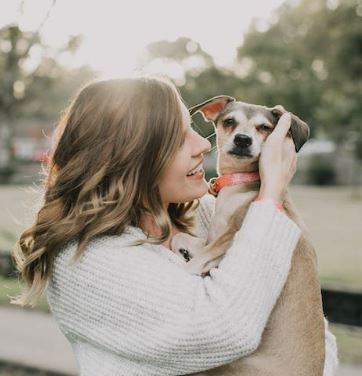
Marissa Delotta, 36, from Dayton, Ohio, is the creative force behind Roverboard.com, a beloved online destination for dog lovers. As a dedicated mom and canine enthusiast, Marissa combines her family experiences with her love for dogs to offer a platform where dog owners can exchange tips, heartwarming stories, and advice. Her website has become a vibrant community for sharing the joys of dog parenting. In her free time, Marissa enjoys exploring dog parks with her family and volunteering at local animal shelters.